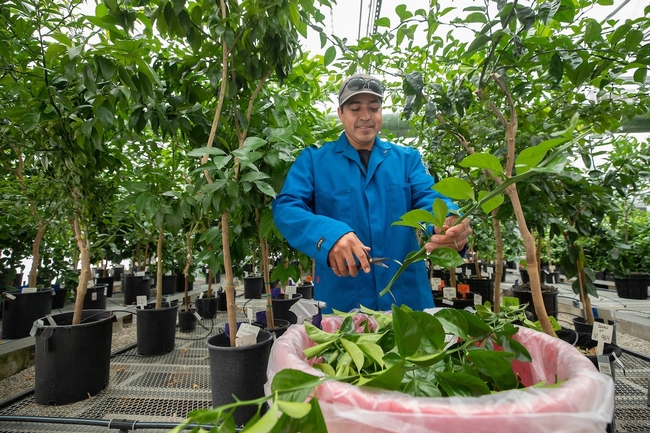
With the emergence of citrus yellow vein clearing virus in a residential citrus grove in Tulare, ag officials are warning growers and hobby farmers to clean their tools after working with trees. Photo by Stan Lim with UC Riverside.
Written by Edward Smith
The detection of a new citrus disease in the city of Tulare marks another threat to the industry, with researchers across the globe working to understand the virus.
Inspectors with the California Department of Food and Agriculture (CDFA) first spotted citrus yellow vein clearing virus in residential citrus trees in Tulare — its first detection in the United States.
While initial research shows the virus is not fatal to trees, the disease affects a tree’s yield, especially for lemons and sour oranges, though it can spread to other citrus, according to a paper from the Horticultural Plant Journal.
Yellow vein disease was first found in Pakistan in 1988 and has since spread to Iran, India, Turkey and Chinese citrus groves. The presence of the disease in nearly all citrus-producing areas of China has spurred significant investment into how to treat the disease.
How the disease first appeared in Tulare County, researchers still don’t know, according to Victoria Hornbaker, director of citrus pest and disease prevention with CDFA. But the disease is spread by insects or by contaminated tools and grafting materials. The citrus whitefly, green citrus aphid, melon aphid and cowpea aphid can all spread the virus as they feed on foliage. Fruit and seeds do not seem to be vectors.
Much remains to be understood about yellow vein disease. The name itself was only meant to be a tentative one. Its effect on citrus is not consistent. Some citrus species appear to be unaffected by the disease, acting only as a reservoir for transmission, according to the USDA.
In lemons and sour orange trees, leaves appear water-soaked and yellowed. Yields in China were reduced by as much as 20% for Eureka lemons, according to the paper in Horticultural Plant Journal. The virus can also transform fruit, making it less marketable.
Weather also seems to play a role in the disease symptoms. During the hottest parts of summer, researchers found reduced symptoms, leading them to believe that high temperatures may limit the virus’ ability to move throughout the plant.
The disease comes as those in the citrus work vigilantly to curb citrus greening disease, also called huanglongbing. The disease, spread by the Asian citrus psyllid, has devastated the Florida citrus industry and has been detected in parts of the Inland Empire and Southern California.
In June, it was announced that inspectors found specimens of the Asian citrus psyllid in a packinghouse and at nearby properties in Woodlake and Lemon Cove.
Citrus grower Matthew Watkins in eastern Tulare County said yellow vein clearing disease is another thing growers must deal with, but he feels relief that it’s not been detected in commercial groves. He said there’s still a lot of uncertainty about the disease, but he feels that normal, safe farming practices will help keep the disease at bay.
No treatment exists yet to deal with the disease. Researchers urge growers and their crews to clean and sanitize equipment between groves. They make the same suggestion for residential citrus growers to clean equipment between working on trees.
Pesticides also exist to control the four known insect species that spread the disease.
The CDFA and the United States Department of Agriculture’s Animal and Plant Health Inspection Service are currently performing an “intensive delimitation survey” which will guide the regulatory approach from the two agencies.
Until then, Watkins says he is simply “learning at the moment.”







